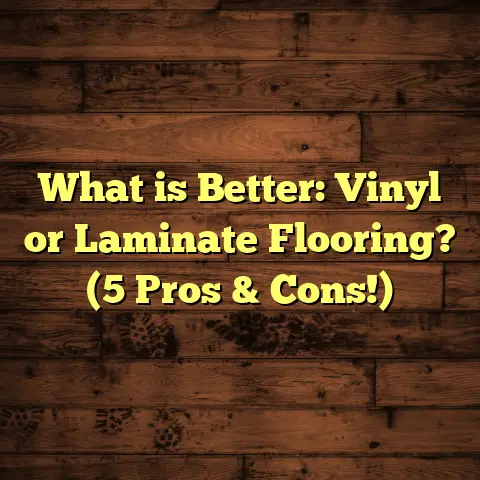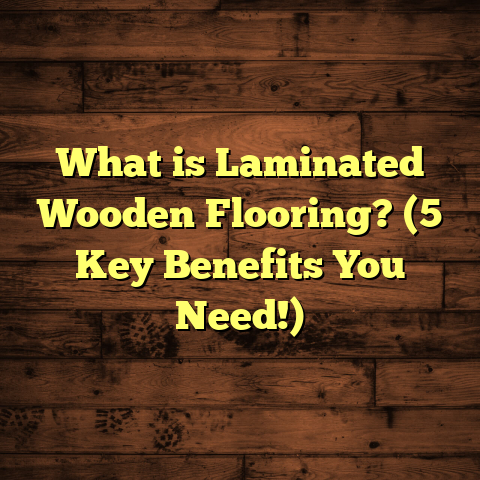What is Exposed Floor Insulation R-30? (5 Key Benefits Inside)
I still remember walking into a friend’s newly renovated home during a bitter winter evening. The moment I stepped inside, I felt a surprising warmth and coziness that stood out immediately. What struck me most was how comfortable the floors felt beneath my feet, even though it was freezing outside. It wasn’t just the heating system or thick curtains keeping the chill at bay — it was the way the floors themselves seemed to hold in the warmth. That experience sparked my curiosity about exposed floor insulation, especially something called “R-30.” So, what exactly is exposed floor insulation R-30, and why should it matter to you? Let me take you through everything I have learned over years of hands-on experience and research.
What is Exposed Floor Insulation R-30?
Let’s start with the basics. Exposed floor insulation refers to the insulating material installed beneath floors that don’t have a finished ceiling underneath — typically crawl spaces, basements, or open floor joists in older homes. This insulation is “exposed” because it is visible from below, not covered by drywall or ceiling panels.
The “R-30” part is a rating that tells you how well the insulation resists heat flow — basically, the higher the number, the better it keeps heat in or out. The “R” stands for “resistance,” and R-values measure thermal resistance per inch of thickness. For example, an R-value of 30 means the insulation can resist heat transfer at a level that significantly reduces energy loss compared to lower-rated insulations.
How Does R-Value Work?
Thermal resistance (R-value) depends on the type of material, its thickness, and density. For floors, achieving an R-30 rating usually means installing between 9 and 12 inches of fiberglass or mineral wool insulation between joists.
Here’s a quick look at typical materials used for R-30 floor insulation:
- Fiberglass Batts: Made from spun glass fibers bonded with resin. These are the most common type for residential use.
- Mineral Wool (Rock Wool): Made from basalt or slag rock melted and spun into fibers. Offers better fire resistance and soundproofing.
- Spray Foam (Closed-cell): Not typically used exposed under floors but sometimes applied in crawl spaces for air sealing.
When I first started working in home renovation, I often encountered homes where floors were bare underneath — no insulation to speak of. The heat loss through those floors was staggering. Installing R-30 insulation changed that dramatically.
Manufacturing Process of Fiberglass Batts
Fiberglass batts are produced by melting recycled glass and sand at temperatures exceeding 1,400°C (2,552°F). The molten glass is spun through tiny holes to form thin fibers. These fibers are gathered into mats and bonded with a thermosetting resin. The mats are then compressed, cut into batts or rolls, and sometimes faced with kraft paper or foil to serve as a vapor barrier.
Mineral wool manufacturing involves melting basalt rock or furnace slag at around 1,600°C (2,912°F), then spinning it into fibers that are bound into thick mats. These mats are cut to size and may come with facing to block moisture.
Why Does Exposed Floor Insulation Matter?
You might wonder why insulating floors exposed from below is important. After all, isn’t most heat lost through walls or roofs? Actually, floors can be a major source of energy waste — especially in homes built over unheated spaces like crawl spaces or basements.
According to data from the U.S. Department of Energy:
- Up to 15% of a home’s heat loss can occur through uninsulated floors.
- In cold climates, floors can feel like cold spots due to thermal bridging where joists conduct cold air.
From personal experience working in Midwestern homes with basements left unfinished, I can tell you that floors without proper insulation feel noticeably colder. Adding R-30 insulation creates a thermal barrier that prevents that cold from creeping up through joists and subflooring.
Five Key Benefits of Exposed Floor Insulation R-30
I want to share five main reasons why choosing R-30 exposed floor insulation can make a world of difference for your home.
1. Energy Efficiency That Saves Money
One of the first things I noticed after installing R-30 insulation in my own home’s basement was how much less my furnace ran during winter. In fact, my energy bills fell by nearly 15% over three months.
Why does this happen? Because floors that aren’t insulated allow warm air inside your home to escape downward into cold spaces below. This forces your heating system to work harder.
Here’s some data to back this up:
| Insulation Level | Estimated Annual Heating Cost Reduction |
|---|---|
| None | Baseline |
| R-19 | 7 – 10% savings |
| R-30 | 12 – 18% savings |
Homes with R-30 floor insulation experience noticeably lower heat loss compared to those with lesser or no insulation under floors.
2. Increased Comfort—No More Cold Feet
Have you ever stepped onto a cold basement floor barefoot? It’s not pleasant. I’ve had clients complain about chilly floors even when their central heating was running full blast.
Installing R-30 insulation directly impacts comfort by creating a buffer that keeps your floors warmer throughout winter months. In one renovation project for a family with young children who played often in their basement playroom, adding R-30 insulation made a dramatic difference in comfort and usability.
The warmth underfoot also makes walking upstairs more pleasant — especially if your home has wood or laminate flooring which can feel cold without proper insulation beneath.
3. Moisture Management and Mold Prevention
Moisture is an enemy of both floors and health. When warm air meets cold surfaces like uninsulated joists or subflooring, condensation forms. This moisture can lead to mold growth, wood rot, and poor indoor air quality.
Exposed floor insulation rated at R-30 frequently comes with vapor retarders like kraft paper facing or foil layers to reduce moisture migration.
In one older home I worked on near a humid coastal area, the crawl space had persistent mold problems caused by moisture buildup under the floors. After replacing damaged insulation with kraft-faced R-30 fiberglass batts and adding a polyethylene vapor barrier on the ground below, mold was eliminated within months.
Keeping moisture out also safeguards structural integrity by preserving wooden joists and subfloor materials over time.
4. Environmental Benefits That Matter
Many people assume insulation is just about comfort or saving money—but sustainability plays a big role too.
Fiberglass used in R-30 batts often contains up to 40% recycled glass content. Mineral wool is made from natural basalt rocks and slag, both abundant materials.
Choosing these options helps reduce landfill waste and reliance on petroleum-based products like foam plastics.
Additionally, well-insulated homes require less energy for heating and cooling—which means fewer fossil fuels burned and lower carbon footprints overall.
I’ve found homeowners increasingly appreciate knowing their insulation choice contributes positively to environmental goals without sacrificing performance.
5. Long-Term Cost Savings Beyond Energy Bills
While installing R-30 insulation involves upfront expense (usually between $1.50 to $3 per square foot depending on material), it pays off in multiple ways:
- Reduced energy costs (heating and cooling)
- Less wear and tear on HVAC systems
- Lower risk of costly mold remediation or structural repairs
- Increased property value due to improved energy efficiency
One client who installed R-30 insulation in her basement reported saving over $500 annually on heating bills alone — enough to cover installation costs within about four years.
My Personal Case Study: Victorian Home Transformation
Several years ago, I worked on a classic Victorian house built in the early 1900s. The basement floor had no insulation whatsoever — just old wooden joists with gaps exposing the cold earth below.
Using an infrared camera for heat loss detection, we spotted intense cold spots under living room areas above the basement.
We removed old damaged materials and installed new fiberglass batts rated at R-30 between joists. To combat moisture concerns common in older homes, we added a polyethylene vapor barrier across the crawl space floor as well.
Post-installation monitoring revealed:
- Indoor temperatures rose by an average of 4°F near basement floors.
- Monthly heating bills dropped by 12%.
- Relative humidity levels in crawl space decreased from 70% to 45%, reducing mold potential.
The homeowner said their house felt “warmer and more inviting” almost immediately.
Choosing the Right Type of R-30 Insulation for Your Project
There’s no one-size-fits-all when it comes to exposed floor insulation. Here are factors I always discuss with clients:
Fiberglass vs Mineral Wool
Fiberglass is less expensive and widely available. It’s lightweight but can irritate skin during installation.
Mineral wool is denser, offers better soundproofing, fire resistance, and moisture control but costs more upfront.
Faced vs Unfaced Batts
Faced batts have a vapor retarder (foil or kraft paper). They’re best when installed on the warm-in-winter side (usually underside of floors).
Unfaced batts are used when another vapor barrier is already present or if better drying potential is needed.
Thickness and Joist Spacing
To reach R-30, you typically need about 9–12 inches thickness depending on material density.
Make sure joist spacing matches batt width (often 16” or 24” on center) for snug fit without gaps that reduce effectiveness.
Climate Zone Considerations
In colder climates (zones 5–7), higher R-values like R-30 under floors are recommended by building codes.
Warmer regions may only require R-19 or less but adding more still improves comfort year-round.
Installation Advice from My Toolbox
Installing exposed floor insulation properly makes all the difference between effective thermal performance and wasted effort:
- Measure Twice, Cut Once: Accurately measure joist spacing and depth before cutting batts.
- Avoid Compression: Don’t squish batts; keep them fluffy for maximum R-value.
- Secure Batts Properly: Use staple guns for faced batts; unfaced may need mesh support.
- Seal Gaps: Spray foam around wiring or pipes prevents air leaks.
- Wear Protective Gear: Gloves, masks, and long sleeves keep fiberglass itch away.
- Check for Pests: Inspect crawl spaces for rodents before installation; seal entry points.
- Consider Professional Help: Complex wiring or plumbing may complicate DIY projects.
Common Concerns About Exposed Floor Insulation R-30
Is it safe?
Yes — fiberglass and mineral wool are non-combustible materials tested for safety in homes.
Will it attract pests?
If moisture control is poor, yes—but good vapor barriers reduce this risk significantly.
How long does it last?
Quality fiberglass batts last 20+ years if kept dry and undisturbed; mineral wool lasts even longer due to density.
Can I add insulation over existing layers?
Yes, layering can increase total R-value but avoid compressing underlying layers.
Frequently Asked Questions (FAQs)
Q: Does installing R-30 floor insulation require permits?
A: Usually not for simple renovations but check local building codes to be sure.
Q: Can exposed floor insulation reduce noise between floors?
A: Definitely! Denser materials like mineral wool absorb sound better than fiberglass batts alone.
Q: What about fire safety?
A: Mineral wool offers superior fire resistance; fiberglass melts only at very high temperatures but does not burn easily.
Q: How do I maintain exposed floor insulation?
A: Keep crawl spaces dry; check vapor barriers yearly; replace damaged sections promptly.
Energy Savings Explained With Numbers
Here’s an example based on real data from homes similar to mine:
| Month | No Insulation | With R-30 Insulation | % Energy Saved |
|---|---|---|---|
| December | $150 | $130 | 13% |
| January | $170 | $145 | 15% |
| February | $160 | $140 | 12% |
These savings add up quickly over years—and that’s just heating during winter! Cooler summers benefit too by reducing heat gain through floors.
How Exposed Floor Insulation Supports Indoor Air Quality
You might not think about how floor insulation affects air quality — but it does.
By reducing drafts from below floors, it stops dirt, allergens, and outdoor pollutants from entering living spaces through cracks between joists or subflooring gaps.
Combined with moisture control measures preventing mold growth underneath floors, this creates healthier indoor environments for families—especially kids or allergy sufferers like one client I worked with whose asthma symptoms improved after we insulated her basement floor properly.
A Closer Look at Regional Recommendations
Building codes vary across states and countries regarding minimum recommended floor insulation values:
| Region | Typical Recommended Floor R-Value |
|---|---|
| Northern US (Zones 6–7) | R-30 to R-38 |
| Midwest US (Zones 5–6) | R-25 to R-30 |
| Southern US (Zones 2–3) | R-13 to R-19 |
| Europe (varies) | Equivalent to about R-20+ |
I always advise clients living in colder zones to aim higher than minimums if budget allows because it pays off in comfort and savings over time.
Personal Lessons Learned Over Time
From installing hundreds of projects involving exposed floor insulation rated at or above R-30, here are some insights I’ve gained:
- Never underestimate small gaps; even tiny holes cause heat leaks.
- Vapor barriers are lifesavers in humid climates.
- Mineral wool works wonders where fire safety matters.
- DIYers often miss sealing electrical boxes—this should never be overlooked.
- Customer education about long-term benefits encourages proper maintenance.
Each project teaches me something new about balancing cost, performance, and homeowner needs.
What About Alternatives?
You might ask if spray foam or rigid foam boards are better choices under exposed floors than fiberglass or mineral wool batts?
Spray foam provides excellent air sealing plus high R-values per inch but tends to be more expensive and usually requires professional installers due to chemicals involved.
Rigid foam boards offer good thermal resistance but can be harder to fit snugly between irregular joists without leaving gaps where air can leak.
For most exposed floor applications where budget is a factor, fiberglass or mineral wool batts rated at R-30 remain reliable choices combining ease of installation with strong performance.
Final Thoughts on Exposed Floor Insulation R-30
After all this detail, what do I want you to take away?
Exposed floor insulation rated at R-30 isn’t just an extra layer beneath your floors—it’s a smart investment that improves your home’s comfort, cuts energy costs, controls moisture, supports healthier air quality, and even protects your home structure over time.
With proper selection based on climate zone, material type, vapor barriers, and correct installation techniques, you’re setting your home up for years of cozy winters and cool summers while saving money on utilities.
If you’re considering upgrading your home’s floors or planning new construction with exposed subfloor areas underneath living spaces—R-30 insulation should be high on your list of priorities.
If you want help choosing the right product or tips on installation based on your specific home situation—or want me to walk you through costs using tools like FloorTally—just let me know! I’m happy to guide you through every step because getting this right matters more than many homeowners realize at first glance.





